View in other NatureServe Network Field Guides
NatureServe
Montana
Utah
Wyoming
Idaho
Wisconsin
British Columbia
South Carolina
Yukon
California
New York
White-tailed Jackrabbit - Lepus townsendii
Native Species
Global Rank:
G5
State Rank:
S5
(see State Rank Reason below)
Agency Status
USFWS:
USFS:
BLM:
External Links
State Rank Reason (see State Rank above)
Species is common and widespread. It is susceptible to Rabbit Hemorrhagic Disease virus, but impacts or potential impacts are unknown.
General Description
We do not yet have descriptive information on this species. Please try the buttons above to search for information from other sources.
Species Range
Montana Range
Range Descriptions
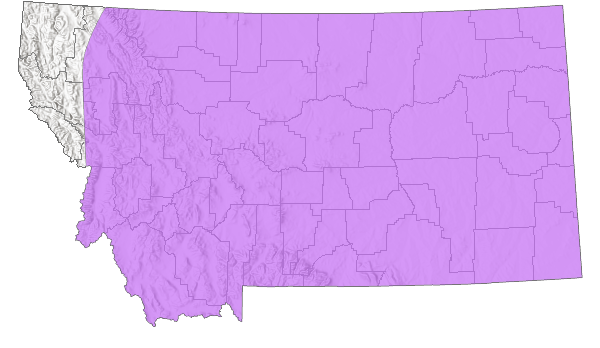
 Native
Native
Western Hemisphere Range
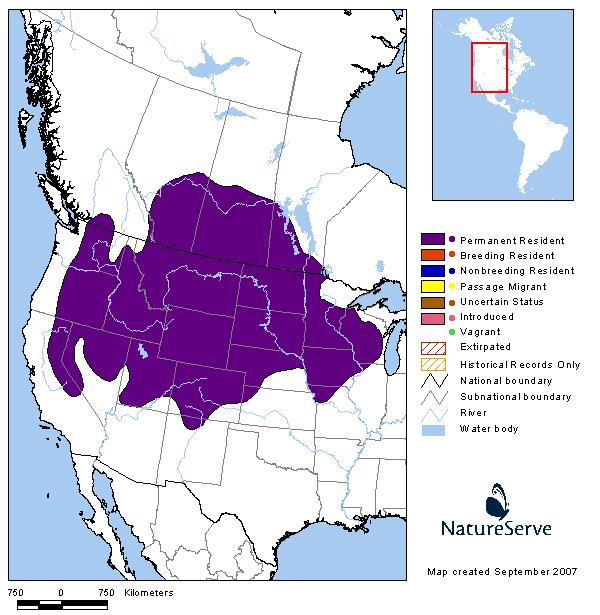
Observations in Montana Natural Heritage Program Database
Number of Observations: 569
(Click on the following maps and charts to see full sized version)
Map Help and Descriptions
Relative Density

Recency
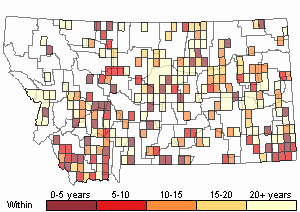
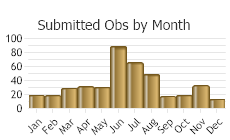
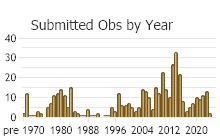
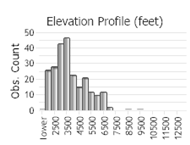 (Observations spanning multiple months or years are excluded from time charts)
(Observations spanning multiple months or years are excluded from time charts)
Migration
Non-migratory.
Habitat
Sage-grassland types. Open areas, retreats to woodlots and riparian only during severe winters (Jones et al. 1983).
National Vegetation Classification System Groups Associated with this Species
Alpine
Alpine - Vegetated
Forest and Woodland
Deciduous Forest and Woodland
Low Elevation - Xeric Forest and Woodland
Shrubland
Arid - Saline Shrubland
Foothills - Montane Shrubland
Sagebrush Shrubland
Grassland
Lowland - Prairie Grassland
Montane - Subalpine Grassland
Sparse and Barren
Sparse and Barren
Wetland and Riparian
Alkaline - Saline Wetlands
Alpine Riparian and Wetland
Peatland
Riparian and Wetland Forest
Riparian Shrubland
Wet Meadow and Marsh
Recently Disturbed or Modified
Introduced Vegetation
Recently Burned
Human Land Use
Agriculture
Developed
Food Habits
Food habits probably vary somewhat between areas. Apparently plants in reproductive or early reproductive stages of development are preferred. Will reingest feces (coprophagy).
Ecology
True hare (precocial young). Occasionally carries tuleremia.
Reproductive Characteristics
Late snow cover may delay onset of breeding. Induced ovulator. Litter size declines in successive litters each year so that overall average is 3 to 4 young/litter (Jones et al. 1983).
Stewardship Responsibility
References
- Literature Cited AboveLegend:
 View Online Publication
View Online Publication Jones, J.K., D.M. Armstrong, R.S. Hoffmann and C. Jones. 1983. Mammals of the northern Great Plains. University of Nebraska Press, Lincoln. 379 pp.
Jones, J.K., D.M. Armstrong, R.S. Hoffmann and C. Jones. 1983. Mammals of the northern Great Plains. University of Nebraska Press, Lincoln. 379 pp.
- Additional ReferencesLegend:
 View Online Publication
View Online Publication
Do you know of a citation we're missing? Anaconda Minerals Company, and Camp, Dresser & McKee. 1981. Anaconda Stillwater Project 6-month environmental baseline report. CDM Project No. 3139. Vol. I Appendix. Jan. 15, 1981.
Anaconda Minerals Company, and Camp, Dresser & McKee. 1981. Anaconda Stillwater Project 6-month environmental baseline report. CDM Project No. 3139. Vol. I Appendix. Jan. 15, 1981. Atkinson, E.C. 1992. Ferruginous hawk (Buteo regalis) inventories on the Dillon Resource Area of southwest Montana: 1992. Montana Natural Heritage Program for Bureau of Land Management, Dillon Resource Area. 34 pp.
Atkinson, E.C. 1992. Ferruginous hawk (Buteo regalis) inventories on the Dillon Resource Area of southwest Montana: 1992. Montana Natural Heritage Program for Bureau of Land Management, Dillon Resource Area. 34 pp. Bauer, Delane, 2002, 2002 Four Seasons Wildlife Study. Savage Mine Report, Richland County, Montana.
Bauer, Delane, 2002, 2002 Four Seasons Wildlife Study. Savage Mine Report, Richland County, Montana. Braun, C.E. And R.G. Streeter. 1968. Observations On the Occurrence of White-Tailed Jackrabbits in the Alpine Zone. J. Mammal. 49: 160-161.
Braun, C.E. And R.G. Streeter. 1968. Observations On the Occurrence of White-Tailed Jackrabbits in the Alpine Zone. J. Mammal. 49: 160-161. Chapman, J.A., and G.A. Feldhamer. 1982. Wild mammals of North America: biology, management, and economics. Johns Hopkins University Press, Baltimore, Maryland.
Chapman, J.A., and G.A. Feldhamer. 1982. Wild mammals of North America: biology, management, and economics. Johns Hopkins University Press, Baltimore, Maryland. Confluence Consulting Inc. 2010. Montana Department of Transportation Wetland Mitigation Monitoring Reports (various sites). MDT Helena, MT.
Confluence Consulting Inc. 2010. Montana Department of Transportation Wetland Mitigation Monitoring Reports (various sites). MDT Helena, MT. Confluence Consulting Inc. 2011. Montana Department of Transportation Wetland Mitigation Monitoring Reports (various sites). MDT Helena, MT.
Confluence Consulting Inc. 2011. Montana Department of Transportation Wetland Mitigation Monitoring Reports (various sites). MDT Helena, MT. Dood, A.R. 1980. Terry Badlands nongame survey and inventory final report. Montana Department of Fish, Wildlife, and Parks and Bureau of Land Management, Helena, MT. 70 pp.
Dood, A.R. 1980. Terry Badlands nongame survey and inventory final report. Montana Department of Fish, Wildlife, and Parks and Bureau of Land Management, Helena, MT. 70 pp. ECON, Inc. (Ecological Consulting Service), Helena, MT., 1976, Colstrip 10 x 20 Area wildlife and wildlife habitat annual monitoring report, 1976. Proj. 135-85-A. December 31, 1976.
ECON, Inc. (Ecological Consulting Service), Helena, MT., 1976, Colstrip 10 x 20 Area wildlife and wildlife habitat annual monitoring report, 1976. Proj. 135-85-A. December 31, 1976. ECON, Inc. (Ecological Consulting Service), Helena, MT., 1977, Colstrip 10 x 20 Area wildlife and wildlife habitat annual monitoring report, 1977. Proj. 164-85-A. December 31, 1977.
ECON, Inc. (Ecological Consulting Service), Helena, MT., 1977, Colstrip 10 x 20 Area wildlife and wildlife habitat annual monitoring report, 1977. Proj. 164-85-A. December 31, 1977. ECON, Inc. (Ecological Consulting Service), Helena, MT., 1979, Annual wildllife report of the Colstrip Area for 1978. Proj. 195-85-A. April 6, 1979.
ECON, Inc. (Ecological Consulting Service), Helena, MT., 1979, Annual wildllife report of the Colstrip Area for 1978. Proj. 195-85-A. April 6, 1979. ECON, Inc. (Ecological Consulting Service), Helena, MT., 1979, Annual wildllife report of the Colstrip Area for 1979, including a special raptor research study. Proj. 216-85-A. March 1, 1980.
ECON, Inc. (Ecological Consulting Service), Helena, MT., 1979, Annual wildllife report of the Colstrip Area for 1979, including a special raptor research study. Proj. 216-85-A. March 1, 1980. Eng, R.L. 1976. Wildlife Baseline Study [for West Fork of the Stillwater and Picket Pin drainages]
Eng, R.L. 1976. Wildlife Baseline Study [for West Fork of the Stillwater and Picket Pin drainages] Farmer, Pat, and Dean Culwell, Westech, Inc. [Western Technology and Engineering], Helena, MT., 1981, Terrestrial wildlife reconnaissance. March 1981.
Farmer, Pat, and Dean Culwell, Westech, Inc. [Western Technology and Engineering], Helena, MT., 1981, Terrestrial wildlife reconnaissance. March 1981. Farmer, Patrick. J., et al., Western Technology and Eng., Inc., Helena, MT., 1984, Montana Tunnels Project Baseline Terrestrial Wildlife Study. December 14, 1984. In Application for a Hard Rock Operating Permit, Montana Tunnels Project, Jefferson County, Montana. Vol. 3. Environmental Baseline Reports. (Centennial Minerals, Inc., Hydrometrics, 1984?)
Farmer, Patrick. J., et al., Western Technology and Eng., Inc., Helena, MT., 1984, Montana Tunnels Project Baseline Terrestrial Wildlife Study. December 14, 1984. In Application for a Hard Rock Operating Permit, Montana Tunnels Project, Jefferson County, Montana. Vol. 3. Environmental Baseline Reports. (Centennial Minerals, Inc., Hydrometrics, 1984?) Feigley, H.P. 1981. Studies on native small mammals as intermediate hosts of Echinococcus multilocularis. M.Sc. Thesis. Bozeman, Montana: Montana State University. 50 p.
Feigley, H.P. 1981. Studies on native small mammals as intermediate hosts of Echinococcus multilocularis. M.Sc. Thesis. Bozeman, Montana: Montana State University. 50 p. Fjell, Alan K., 1986, Peabody Coal Company Big Sky Mine, Rosebud County, MT. Wildlife monitoring report: 1985 field season. March 1986.
Fjell, Alan K., 1986, Peabody Coal Company Big Sky Mine, Rosebud County, MT. Wildlife monitoring report: 1985 field season. March 1986. Fjell, Alan K., and Brian R. Mahan, compilers., 1984, Peabody Coal Company Big Sky Mine, Rosebud County, MT. Wildlife monitoring report: 1983 field season. February 1984.
Fjell, Alan K., and Brian R. Mahan, compilers., 1984, Peabody Coal Company Big Sky Mine, Rosebud County, MT. Wildlife monitoring report: 1983 field season. February 1984. Fjell, Alan K., and Brian R. Mahan., 1983, Peabody Coal Company Big Sky Mine, Rosebud County, MT. Wildlife monitoring report: 1982 field season. May 1983.
Fjell, Alan K., and Brian R. Mahan., 1983, Peabody Coal Company Big Sky Mine, Rosebud County, MT. Wildlife monitoring report: 1982 field season. May 1983. Fjell, Alan K., and Brian R. Mahan., 1985, Peabody Coal Company Big Sky Mine, Rosebud County, MT. Wildlife monitoring report: 1984 field season. February 1985.
Fjell, Alan K., and Brian R. Mahan., 1985, Peabody Coal Company Big Sky Mine, Rosebud County, MT. Wildlife monitoring report: 1984 field season. February 1985. Flinders, J.T. and R.M. Hansen. 1973. Abundance and dispersion of Leoprids within a shortgrass ecosystem. Journal of Mammalogy. 54(1): 287-29.
Flinders, J.T. and R.M. Hansen. 1973. Abundance and dispersion of Leoprids within a shortgrass ecosystem. Journal of Mammalogy. 54(1): 287-29. Foresman, K.R. 2001. The wild mammals of Montana. American Society of Mammalogists, Special Publication Number 12. Lawrence, KS. 278 pp.
Foresman, K.R. 2001. The wild mammals of Montana. American Society of Mammalogists, Special Publication Number 12. Lawrence, KS. 278 pp. Foresman, K.R. 2012. Mammals of Montana. Second edition. Mountain Press Publishing, Missoula, Montana. 429 pp.
Foresman, K.R. 2012. Mammals of Montana. Second edition. Mountain Press Publishing, Missoula, Montana. 429 pp. Giddings, B.J. 1986. Ecology of the bobcat in a prairie rangeland-agricultural environment in eastern Montana: home range, size, movements, and habitat use of bobcats in a prairie rangeland environment. MS Thesis. Montana State University. Bozeman, Montana.
Giddings, B.J. 1986. Ecology of the bobcat in a prairie rangeland-agricultural environment in eastern Montana: home range, size, movements, and habitat use of bobcats in a prairie rangeland environment. MS Thesis. Montana State University. Bozeman, Montana. Gniadek, S. 1983. Southwest Glendive Wildlife Baseline Inventory. Miles City, Mont: Bureau of Land Management, Miles City District Office. 56 pp with appendices.
Gniadek, S. 1983. Southwest Glendive Wildlife Baseline Inventory. Miles City, Mont: Bureau of Land Management, Miles City District Office. 56 pp with appendices. Haight, C.P. 1937. Some observations on the predator-prey complex in the Gallatin Valley. M.Sc. Thesis. Bozeman, Montana: Montana State University. 58 p.
Haight, C.P. 1937. Some observations on the predator-prey complex in the Gallatin Valley. M.Sc. Thesis. Bozeman, Montana: Montana State University. 58 p. Harmata, A.R. 1991. Impacts of oil and gas development on raptors associated with Kevin Rim, Montana. Bozeman, MT: Montana State University. Unpublished report by the Kevin Rim Raptor Study Group. Prepared for the USDI BLM, Great Falls Resource Area, Great Falls, MT. 106 p.
Harmata, A.R. 1991. Impacts of oil and gas development on raptors associated with Kevin Rim, Montana. Bozeman, MT: Montana State University. Unpublished report by the Kevin Rim Raptor Study Group. Prepared for the USDI BLM, Great Falls Resource Area, Great Falls, MT. 106 p. Hendricks, P. and M. Roedel. 2001. A faunal survey of the Centennial Valley Sandhills, Beaverhead County, Montana. Report to the U.S. Bureau of Land Management and U.S. Fish and Wildlife Service. Montana Natural Heritage Program, Helena, MT. 44 p.
Hendricks, P. and M. Roedel. 2001. A faunal survey of the Centennial Valley Sandhills, Beaverhead County, Montana. Report to the U.S. Bureau of Land Management and U.S. Fish and Wildlife Service. Montana Natural Heritage Program, Helena, MT. 44 p. Hendricks, P., S. Lenard, D.M. Stagliano, and B.A. Maxell. 2013. Baseline nongame wildlife surveys on the Fort Peck Indian Reservation. Report to the Assiniboine and Sioux Tribes of the Fort Peck Indian Reservation. Montana Natural Heritage Program, Helena, MT. 83 p.
Hendricks, P., S. Lenard, D.M. Stagliano, and B.A. Maxell. 2013. Baseline nongame wildlife surveys on the Fort Peck Indian Reservation. Report to the Assiniboine and Sioux Tribes of the Fort Peck Indian Reservation. Montana Natural Heritage Program, Helena, MT. 83 p. Hoffmann, R.S. and D.L. Pattie. 1968. A guide to Montana mammals: identification, habitat, distribution, and abundance. Missoula, MT: University of Montana. 133 p.
Hoffmann, R.S. and D.L. Pattie. 1968. A guide to Montana mammals: identification, habitat, distribution, and abundance. Missoula, MT: University of Montana. 133 p. Hoffmann, R.S., P.L. Wright, and F.E. Newby. 1969. The distribution of some mammals in Montana. I. Mammals other than bats. Journal of Mammalogy 50(3): 579-604.
Hoffmann, R.S., P.L. Wright, and F.E. Newby. 1969. The distribution of some mammals in Montana. I. Mammals other than bats. Journal of Mammalogy 50(3): 579-604. Humphris, Michael., 1990, Wildlife Monitoring Report. Spring Creek Coal Company 1990 Mining Annual Report. Appendix I. April 11, 1990.
Humphris, Michael., 1990, Wildlife Monitoring Report. Spring Creek Coal Company 1990 Mining Annual Report. Appendix I. April 11, 1990. Humphris, Michael., 1991, Wildlife Monitoring Report. Spring Creek Coal Company 1991 Mining Annual Report. Appendix I. April 11, 1991.
Humphris, Michael., 1991, Wildlife Monitoring Report. Spring Creek Coal Company 1991 Mining Annual Report. Appendix I. April 11, 1991. Humphris, Michael., 1993, Wildlife Monitoring Report. Spring Creek Coal Company 1993 Mining Annual Report. Appendix I. April 11, 1993.
Humphris, Michael., 1993, Wildlife Monitoring Report. Spring Creek Coal Company 1993 Mining Annual Report. Appendix I. April 11, 1993. Humphris, Michael., 1994, Wildlife Monitoring Report. Spring Creek Coal Company 1994 Mining Annual Report. Appendix I. April 1994.
Humphris, Michael., 1994, Wildlife Monitoring Report. Spring Creek Coal Company 1994 Mining Annual Report. Appendix I. April 1994. Joslin, Gayle, and Heidi B. Youmans. 1999. Effects of recreation on Rocky Mountain wildlife: a review for Montana. [Montana]: Montana Chapter of the Wildlife Society.
Joslin, Gayle, and Heidi B. Youmans. 1999. Effects of recreation on Rocky Mountain wildlife: a review for Montana. [Montana]: Montana Chapter of the Wildlife Society. Lim, B.K. 1987. Lepus townsendii. Mammalian Species 288:1-6.
Lim, B.K. 1987. Lepus townsendii. Mammalian Species 288:1-6. Martin, P.R., K. Dubois and H.B. Youmans. 1981. Terrestrial wildlife inventory in selected coal areas, Powder River resources area final report. Montana Department of Fish, Wildlife and Parks and Bureau of Land Management, Helena, MT. No. YA-553-CTO- 24. 288 p.
Martin, P.R., K. Dubois and H.B. Youmans. 1981. Terrestrial wildlife inventory in selected coal areas, Powder River resources area final report. Montana Department of Fish, Wildlife and Parks and Bureau of Land Management, Helena, MT. No. YA-553-CTO- 24. 288 p. Matthews, W.L. 1980a. Wibaux-Beach comparison study: Sydney, Glendive and Plevna Study Areas. Bureau of Land Management, Miles City, MT. 50 p.
Matthews, W.L. 1980a. Wibaux-Beach comparison study: Sydney, Glendive and Plevna Study Areas. Bureau of Land Management, Miles City, MT. 50 p. Matthews, W.L. 1981. Broadus-Pumpkin Creek baseline inventory - wildlife. Bureau of Land Management, Miles City, MT. 83 p.
Matthews, W.L. 1981. Broadus-Pumpkin Creek baseline inventory - wildlife. Bureau of Land Management, Miles City, MT. 83 p. Maxell, B.A. 2016. Northern Goshawk surveys on the Beartooth, Ashland, and Sioux Districts of the Custer-Gallatin National Forest: 2012-2014. Montana Natural Heritage Program. Helena, MT. 114pp.
Maxell, B.A. 2016. Northern Goshawk surveys on the Beartooth, Ashland, and Sioux Districts of the Custer-Gallatin National Forest: 2012-2014. Montana Natural Heritage Program. Helena, MT. 114pp. McGahan, J. 1966. Ecology of the Golden Eagle. M.S. thesis. University of Montana, Missoula. 78 pp.
McGahan, J. 1966. Ecology of the Golden Eagle. M.S. thesis. University of Montana, Missoula. 78 pp. Montana Dept. of State Lands, 1976, Draft environmental impact statement for proposed open cut mining contract for Amercan Colloid Company. November 12, 1976.
Montana Dept. of State Lands, 1976, Draft environmental impact statement for proposed open cut mining contract for Amercan Colloid Company. November 12, 1976. Mundinger, J.G. 1975. The influence of rest-rotation grazing management on waterfowl production on stock-water reservoirs in Phillips County, Montana. M.Sc. Thesis. Bozeman, MT: Montana State University. 100 p.
Mundinger, J.G. 1975. The influence of rest-rotation grazing management on waterfowl production on stock-water reservoirs in Phillips County, Montana. M.Sc. Thesis. Bozeman, MT: Montana State University. 100 p. Oechsli, L.M. 2000. Ex-urban development in the Rocky Mountain West: consequences for native vegetation, wildlife diversity, and land-use planning in Big Sky, Montana. M.Sc. Thesis. Montana State University, Bozeman. 73 p.
Oechsli, L.M. 2000. Ex-urban development in the Rocky Mountain West: consequences for native vegetation, wildlife diversity, and land-use planning in Big Sky, Montana. M.Sc. Thesis. Montana State University, Bozeman. 73 p. Pattie, D.L. and N.A. M. Verbeek. 1967. Alpine mammals of the Beartooth Plateau. Northwest Science 41(3): 110-117.
Pattie, D.L. and N.A. M. Verbeek. 1967. Alpine mammals of the Beartooth Plateau. Northwest Science 41(3): 110-117. Powder River Eagle Studies, Inc., Gillette, WY., 1996, Spring Creek Mine 1995 Wildlife Monitoring Studies. Spring Creek Coal Company 1995-1996 Mining Annual Report. Vol. I, App. I. May 1996.
Powder River Eagle Studies, Inc., Gillette, WY., 1996, Spring Creek Mine 1995 Wildlife Monitoring Studies. Spring Creek Coal Company 1995-1996 Mining Annual Report. Vol. I, App. I. May 1996. Powder River Eagle Studies, Inc., Gillette, WY., 1997, Spring Creek Mine 1996 Wildlife Monitoring Studies. February 1997.
Powder River Eagle Studies, Inc., Gillette, WY., 1997, Spring Creek Mine 1996 Wildlife Monitoring Studies. February 1997. Reid, F. 2006. Peterson Field Guide to Mammals of North America, 4th Edition. Houghton Mifflin Company: Boston and New York, 608 pp.
Reid, F. 2006. Peterson Field Guide to Mammals of North America, 4th Edition. Houghton Mifflin Company: Boston and New York, 608 pp. Rust, H. J. 1946. Mammals of northern Idaho. J. Mammal. 27(4): 308-327.
Rust, H. J. 1946. Mammals of northern Idaho. J. Mammal. 27(4): 308-327. Schladweiler, P. 1980. Coyote densities, small mammal population indices, and big game fawn production and survival in the various study areas. State of Montana Wildlife Research, Proj. No. W-120-R-11. 78 pp.
Schladweiler, P. 1980. Coyote densities, small mammal population indices, and big game fawn production and survival in the various study areas. State of Montana Wildlife Research, Proj. No. W-120-R-11. 78 pp. Schladweiler, Philip, and John P. Weigand., 1983, Relationships of endrin and other chlorinated hydrocarbon compounds to wildlife in Montana, 1981-1982. September 1983.
Schladweiler, Philip, and John P. Weigand., 1983, Relationships of endrin and other chlorinated hydrocarbon compounds to wildlife in Montana, 1981-1982. September 1983. Schomburg, J.W. 2003. Development and evaluation of predictive models for managing Golden Eagle electrocutions. M.Sc. Thesis. Bozeman, MT: Montana State Universtiy. 98 p.
Schomburg, J.W. 2003. Development and evaluation of predictive models for managing Golden Eagle electrocutions. M.Sc. Thesis. Bozeman, MT: Montana State Universtiy. 98 p. Spring Creek Coal Company., 1992, Wildlife Monitoring Report. Spring Creek Coal Company 1992 Mining Annual Report. Appendix I.
Spring Creek Coal Company., 1992, Wildlife Monitoring Report. Spring Creek Coal Company 1992 Mining Annual Report. Appendix I. Thompson, L.S. 1981. Circle West wildlife monitoring study: Third annual report. Technical report No. 8. Montana Department of Natural Resources and Conservation. Helena, Montana.
Thompson, L.S. 1981. Circle West wildlife monitoring study: Third annual report. Technical report No. 8. Montana Department of Natural Resources and Conservation. Helena, Montana. Thunderbird Wildlife Consulting, Inc., Gillette, WY., 2003, 2002 wildlife monitoring report: Big Sky Mine. February 2003.
Thunderbird Wildlife Consulting, Inc., Gillette, WY., 2003, 2002 wildlife monitoring report: Big Sky Mine. February 2003. Trout, R.G. 1978. Small mammal abundance and distribution in the Missouri River Breaks, Montana. M.Sc. Thesis. Bozeman, Montana: Montana State University. 64 p.
Trout, R.G. 1978. Small mammal abundance and distribution in the Missouri River Breaks, Montana. M.Sc. Thesis. Bozeman, Montana: Montana State University. 64 p. Tschache, O.P. 1970. Effects of ecological changes induced by various sagebrush control techniques on small mammal populations. M.Sc. Thesis. Bozeman, MT: Montana State University. 51 p.
Tschache, O.P. 1970. Effects of ecological changes induced by various sagebrush control techniques on small mammal populations. M.Sc. Thesis. Bozeman, MT: Montana State University. 51 p. Urban, Larry, 2002, Biological Resources Report: Wagner Pit Wetland Restoration Site. Proj. No. STPX 56(50) CN 4645. February 23, 2002. In Wgner Pit WS#13 Upper Yellowstone, Yellowstone County. Fin. Dist. 5 AdminDist 5.
Urban, Larry, 2002, Biological Resources Report: Wagner Pit Wetland Restoration Site. Proj. No. STPX 56(50) CN 4645. February 23, 2002. In Wgner Pit WS#13 Upper Yellowstone, Yellowstone County. Fin. Dist. 5 AdminDist 5. Van Horn, R.C. 1993. Ferruginous Hawk and Prairie Falcon reproductive and behavioral responses to human activity near the Kevin Rim, Montana. M.Sc. Thesis. Bozeman, Montana: Montana State University. 86 p.
Van Horn, R.C. 1993. Ferruginous Hawk and Prairie Falcon reproductive and behavioral responses to human activity near the Kevin Rim, Montana. M.Sc. Thesis. Bozeman, Montana: Montana State University. 86 p. VTN Environmental Sciences, Sheridan, Wyoming for Montana Dept. of State Lands, 1973, Environmental Analysis Decker Coal Company Mine, Decker, Montana.
VTN Environmental Sciences, Sheridan, Wyoming for Montana Dept. of State Lands, 1973, Environmental Analysis Decker Coal Company Mine, Decker, Montana. Waage, B.C. 1988. Western Energy Company Rosebud Mine, Colstrip, Montana: Annual Wildlife Monitoring Report, 1988 Field Season. December 1988.
Waage, B.C. 1988. Western Energy Company Rosebud Mine, Colstrip, Montana: Annual Wildlife Monitoring Report, 1988 Field Season. December 1988. Waage, Bruce C., 1991, Western Energy Company Rosebud Mine, Colstrip, Montana: Annual Wildlife Monitoring Report, 1990 Field Season. September 1991.
Waage, Bruce C., 1991, Western Energy Company Rosebud Mine, Colstrip, Montana: Annual Wildlife Monitoring Report, 1990 Field Season. September 1991. Waage, Bruce C., 1995, Western Energy Company Rosebud Mine, Colstrip, Montana:1994 Annual Wildlife Monitoring Report; December 1, 1993 - November 30, 1994. February 27, 1995.
Waage, Bruce C., 1995, Western Energy Company Rosebud Mine, Colstrip, Montana:1994 Annual Wildlife Monitoring Report; December 1, 1993 - November 30, 1994. February 27, 1995. Waage, Bruce C., 1999, Western Energy Company Rosebud Mine, Colstrip, Montana: 1998 Annual Wildlife Monitoring Report; December 1, 1997 - November 30, 1998 Survey Period. February 24, 1999.
Waage, Bruce C., 1999, Western Energy Company Rosebud Mine, Colstrip, Montana: 1998 Annual Wildlife Monitoring Report; December 1, 1997 - November 30, 1998 Survey Period. February 24, 1999. Western Energy Co., Colstrip, MT., 1981, Western Energy Company's Application for a Surface Mining Permit: Area C - Block 1. Vol. 1. May 1981.
Western Energy Co., Colstrip, MT., 1981, Western Energy Company's Application for a Surface Mining Permit: Area C - Block 1. Vol. 1. May 1981. Western Technology & Engineering, Inc. (WESTECH)., 1991, 1991 Bull Mountains Mine No. 1 Terrestrial Wildlife Monitoring Study. In Meridian Minerals Company Bull Mountains Mine No. 1 Permit Application, Musselshell County, Montana. Vol. 7 of 14: Section 26
Western Technology & Engineering, Inc. (WESTECH)., 1991, 1991 Bull Mountains Mine No. 1 Terrestrial Wildlife Monitoring Study. In Meridian Minerals Company Bull Mountains Mine No. 1 Permit Application, Musselshell County, Montana. Vol. 7 of 14: Section 26 Western Technology and Engineering, Inc. (WESTECH), Helena, MT., 1994, Terrestrial Wildlife Reconnaissance: Interim Report. Golden Sunlight Mines, Inc., Oxide Expansion. February 1994.
Western Technology and Engineering, Inc. (WESTECH), Helena, MT., 1994, Terrestrial Wildlife Reconnaissance: Interim Report. Golden Sunlight Mines, Inc., Oxide Expansion. February 1994. Western Technology and Engineering, Inc. (WESTECH). 1994. Wildlife Monitoring Absaloka Mine Area Annual Report, 1993. Montana SMP 85005. OSMP Montana 0007c. Mar. 12, 1994.
Western Technology and Engineering, Inc. (WESTECH). 1994. Wildlife Monitoring Absaloka Mine Area Annual Report, 1993. Montana SMP 85005. OSMP Montana 0007c. Mar. 12, 1994. Western Technology and Engineering, Inc. (WESTECH)., 1990, Wildlife Monitoring: Absaloka Mine Area Annual Report, 1990. 12/21/89-12/20/90. Montana SMP 85005 R1. OSMP Montana 0007B. Febr. 15, 1991.
Western Technology and Engineering, Inc. (WESTECH)., 1990, Wildlife Monitoring: Absaloka Mine Area Annual Report, 1990. 12/21/89-12/20/90. Montana SMP 85005 R1. OSMP Montana 0007B. Febr. 15, 1991. Western Technology and Engineering, Inc. (WESTECH)., 1993, Wildlife Monitoring Asaloka Mine Area Annual Report, 1992. Montana SMP 85005 R1. OSMP Montana 00078. 1993.
Western Technology and Engineering, Inc. (WESTECH)., 1993, Wildlife Monitoring Asaloka Mine Area Annual Report, 1992. Montana SMP 85005 R1. OSMP Montana 00078. 1993. Western Technology and Engineering, Inc. (WESTECH)., 1999, Wildlife Monitoring Absaloka Mine Area Annual Report, 1998. SMP 85005. OSMP Montana 0007E. April 1999.
Western Technology and Engineering, Inc. (WESTECH)., 1999, Wildlife Monitoring Absaloka Mine Area Annual Report, 1998. SMP 85005. OSMP Montana 0007E. April 1999. Western Technology and Engineering, Inc. (WESTECH)., 2000, Wildlife Monitoring Absaloka Mine Area Annual Report, 1999. Montana SMP 85005. OSMP Montana 0007E. February 2000.
Western Technology and Engineering, Inc. (WESTECH)., 2000, Wildlife Monitoring Absaloka Mine Area Annual Report, 1999. Montana SMP 85005. OSMP Montana 0007E. February 2000. Western Technology and Engineering, Inc. (WESTECH)., 2001, Wildlife Monitoring Absaloka Mine Area Annual Report, 2000. Montana SMP 85005. OSMP Montana 0007E. February 2001.
Western Technology and Engineering, Inc. (WESTECH)., 2001, Wildlife Monitoring Absaloka Mine Area Annual Report, 2000. Montana SMP 85005. OSMP Montana 0007E. February 2001. Westmoreland Resources, Inc., Hardin, MT., 1983, 1980 Wildlife Monitoring Report. 12/21/79-12/20-80.
Westmoreland Resources, Inc., Hardin, MT., 1983, 1980 Wildlife Monitoring Report. 12/21/79-12/20-80. Zackheim, K. 1973. Exhibit H: Wildlife Study. In Ash Grove Cement Co. files.
Zackheim, K. 1973. Exhibit H: Wildlife Study. In Ash Grove Cement Co. files.
- Web Search Engines for Articles on "White-tailed Jackrabbit"
- Additional Sources of Information Related to "Mammals"





